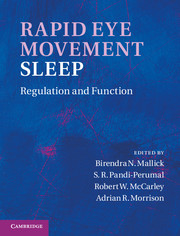Book contents
- Frontmatter
- Contents
- Contributors
- Preface
- Acknowledgments
- Organization
- Section I Historical context
- Section II General biology
- Section III Neuronal regulation
- Section IV Neuroanatomy and neurochemistry
- 19 Aminergic influences in the regulation of basic REM sleep processes
- 20 REM sleep regulation by cholinergic neurons: highlights from 1999 to 2009
- 21 GABAergic modulation of REM sleep
- 22 Glutamatergic regulation of REM sleep
- 23 The role of tuberomammillary nucleus histaminergic neurons, and of their receptors, in the regulation of sleep and waking
- 24 Hypocretinergic system: role in REM-sleep regulation
- 25 Neuropeptides and REM sleep
- 26 Adenosine and glycine in REM-sleep regulation
- 27 Changes in neurotransmitter levels in relation to REM sleep for its regulation
- 28 Pontine areas inhibiting REM sleep
- 29 Neuronal models of REM-sleep control: evolving concepts
- Section V Functional significance
- Section VI Disturbance in the REM sleep-generating mechanism
- Index
- Plate section
- References
28 - Pontine areas inhibiting REM sleep
from Section IV - Neuroanatomy and neurochemistry
Published online by Cambridge University Press: 07 September 2011
- Frontmatter
- Contents
- Contributors
- Preface
- Acknowledgments
- Organization
- Section I Historical context
- Section II General biology
- Section III Neuronal regulation
- Section IV Neuroanatomy and neurochemistry
- 19 Aminergic influences in the regulation of basic REM sleep processes
- 20 REM sleep regulation by cholinergic neurons: highlights from 1999 to 2009
- 21 GABAergic modulation of REM sleep
- 22 Glutamatergic regulation of REM sleep
- 23 The role of tuberomammillary nucleus histaminergic neurons, and of their receptors, in the regulation of sleep and waking
- 24 Hypocretinergic system: role in REM-sleep regulation
- 25 Neuropeptides and REM sleep
- 26 Adenosine and glycine in REM-sleep regulation
- 27 Changes in neurotransmitter levels in relation to REM sleep for its regulation
- 28 Pontine areas inhibiting REM sleep
- 29 Neuronal models of REM-sleep control: evolving concepts
- Section V Functional significance
- Section VI Disturbance in the REM sleep-generating mechanism
- Index
- Plate section
- References
Summary
Summary
In the first half of the twentieth century, research by von Economo and Walle Nauta implicated the hypothalamus in sleep and waking. In the subsequent 50 years the hypothalamus was abandoned and instead the pons was considered to house the neurons regulating states of consciousness. In 1999, the linkage of a hypothalamic peptide, hypocretin, with narcolepsy shifted the emphasis back to the hypothalamus. However, since REM sleep originates from the pons, we sought to identify how the hypothalamus links with the pons, which would elucidate a network map of regions responsible for all three states. In this review we summarize our hypothesis that hypothalamic wake and non-REM sleep active neurons link with a group of i nhibitory pontine neurons to gate the transition to REM sleep. This hypothesis was first publically presented by us at the Society for Neuroscience meeting in 2004. We suggest that the pontine areas inhibiting REM sleep (PAIRS) represent GABA neurons; that these neurons are activated by glucosensing neurons, and neurons involved in emotion and arousal, and that their purpose is to keep the animal upright, mobile, and vigilant as it forages for food.
- Type
- Chapter
- Information
- Rapid Eye Movement SleepRegulation and Function, pp. 280 - 284Publisher: Cambridge University PressPrint publication year: 2011
References
- 1
- Cited by



